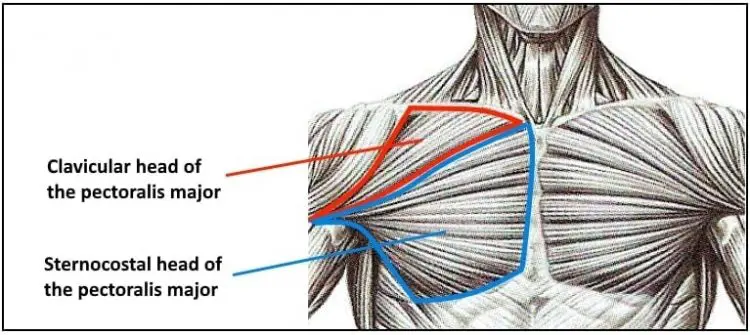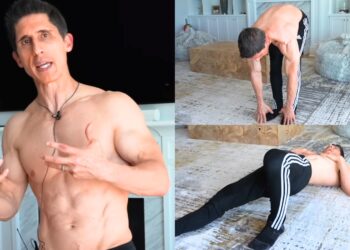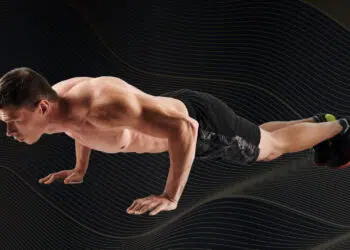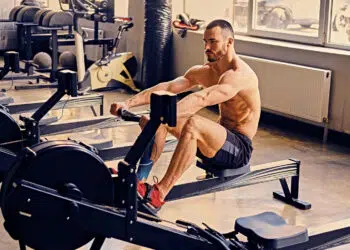Google “chest exercises”, and you’ll be bombarded with thousands of results, most of which will be variations of the bench press, push-ups, and dips. Of course, that’s only to be expected as these ARE arguably the best movements for building bigger, more muscular pecs.
However, there is more to chest training than building strength and size. You also need to develop your flexibility.
Flexible muscles can work through a larger range of motion than tight muscles and are usually less prone to injury. Whatever your training goal, your upper body workouts should include strengthening AND stretching exercises for your pecs.
We’ve published dozens of articles about chest building, so it’s high time we addressed the issue of chest stretching.
In this article, we reveal why and how to stretch your pecs.
Chest Anatomy 101
While you don’t need a degree in functional anatomy to be able to stretch your chest, learning a little more about your muscles may help you train it more effectively. If nothing else, after reading this section, you’ll be able to dazzle your friends, family, and co-workers with your newfound anatomical knowledge!
Level Up Your Fitness: Join our 💪 strong community in Fitness Volt Newsletter. Get daily inspiration, expert-backed workouts, nutrition tips, the latest in strength sports, and the support you need to reach your goals. Subscribe for free!
Pectoralis major
Known as your pecs for short, this is the most significant chest muscle. Its main functions are horizontal flexion, adduction, and medial rotation of your shoulder joint. While the pecs are a single muscle, they are made up of several groups of fibers, often referred to as heads.
- Clavicular head – this is your upper chest. It’s more active during incline movements, such as incline bench press and incline flyes.
- Sternal head – the most prominent pec head, this region forms the bulk of your chest mass. It’s most active during flat pec exercises, such as flat bench presses and pec deck.
- Abdominal head – this is your lower chest. Exercises like dips and high-to-low cable crossovers emphasize this region of your pecs.
Because of the different orientations of the pec muscle fibers, you need to adjust the angle of your arm up and down to stretch all the parts of your pecs. Think of this like doing bench presses, where you do incline, flat, and decline movements to hit the upper, mid, and lower pec fibers. Apply this same logic to stretching your chest.
Pectoralis minor
The Pec minor is a thin, flat muscle that lies underneath the pec major. It assists your pec major during most chest exercises and prevents your shoulders from lifting as you move them. Pec minor does not contribute much to chest size, but it’s still an important muscle.
Why You Need to Stretch Your Chest
So, why should you spend your valuable training time stretching your chest? Good question! The benefits of regular chest stretching include:
Greater range of motion at the shoulder joint
Your pecs control your shoulders, and if they are tight, you won’t be able to move your arms through their full range of motion. This will mean that you won’t be able to lower your weights as far during dumbbell flyes, won’t be able to descend as far during dips, and you may even struggle to push your arms over your head during shoulder presses.
Tight pecs can make many exercises difficult, uncomfortable, and even less productive as a full range of motion is critical for building muscle mass and strength.
Better posture
Posture is the alignment of your joints, which can be good or bad. Tight pecs will pull your shoulders forward into an internally rotated position and may cause your upper back to become hunched. This rounded posture makes you look weaker and older than you really are.
Poor posture is also linked to upper back and neck pain. It can adversely affect shoulder mechanics, possibly leading to shoulder pain, wear and tear, and injuries.
Improved breathing
As your tight pecs pull your shoulders forward into a hyperkyphotic or hunched position, your chest cavity collapses inward, which may reduce lung capacity. Stretching and opening your chest can improve your breathing efficiency, leading to more energy during your workouts and life in general.
Healthier shoulders
Tight pecs can put your shoulders in a mechanically disadvantageous position where they’re both protracted (push forward) and internally rotated. This position puts a lot of pressure on the articular surfaces of the point and the connective tissues.
People often try fixing these problems with rotator cuff and upper back exercises like face pulls. Still, as tight pecs are probably the cause, any strengthening exercises should be accompanied by regular pec stretching.
Prevent adaptive shortening
Lots of chest training combined with habitual sitting means that most people’s pecs are gradually shortening and tightening. This is called adaptive shortening, meaning your pecs adapt to being in a constantly shortened state. Stretching will help reverse this trend and stop adaptive shortening from occurring in the first place.
Level Up Your Fitness: Join our 💪 strong community in Fitness Volt Newsletter. Get daily inspiration, expert-backed workouts, nutrition tips, the latest in strength sports, and the support you need to reach your goals. Subscribe for free!
Reduced risk of injury
Tight pecs are more prone to injury than muscles with a normal range of motion. That’s especially true during exercises that involve a large range of motion, such as pec flyes and wide grip bench presses.
For example, a few minutes of chest stretching per day could save you weeks or even months of lost training if you are unlucky enough to suffer a pec tear.
The 11 Best Chest Stretches
Not sure where to start stretching your chest? Here are the eleven best chest stretching exercises!
1. Doorway chest stretch
The great thing about this exercise is that it comes with a readymade reminder to stretch your pecs regularly. Just do it every time you walk through a suitable doorway! Keeping this trigger in mind, you could conceivably end up stretching your chest 5 to 10-times a day, which is perfect for quickly restoring lost flexibility.
How to do it:
- Stand in an open doorway and place your forearms on the vertical frames, elbows level with your shoulders.
- Gently push your chest through the doorway until you feel a mild stretch in your chest and shoulders.
- Hold for 30-60 seconds, increasing the depth of the stretch as you feel your pecs relax.
- Move your elbows up and down to hit your upper and lower pecs, respectively.
- You can also do this exercise using one arm at a time.
2. Kneeling chest opener
This comprehensive exercise not only stretches your chest. It also stretches your lats and extends your thoracic or upper spine. This means that it’s the ideal antidote for prolonged sitting and should have a noticeable effect on your posture and pec flexibility.
How to do it:
- Knee down in front of a chair or bench.
- Place your hands and forearms on the bench, so your arms are straight.
- Gently lower your head down between your arms until you feel a stretch in your chest and upper back. Imagine you are trying to touch the floor with your chest, but take care NOT to hyperextend your lumbar spine.
- Hold this position for 30-60 seconds. Go a little deeper as you feel your muscles relax.
3. Dumbbell-loaded chest stretch
This exercise uses weights to take your chest into a stretched position. Using dumbbells means this exercise also builds strength when your muscles are extended. Weighted stretches may also trigger muscle growth.
How to do it:
- Lie on your back on an exercise bench. Press your dumbbells up and hold them at arms’ length over your chest with your hands facing inward. Bend your elbows slightly.
- Open your arms and lower the weights out and down to your sides. Go as far as you comfortably can without hyperextending your shoulders.
- Hold this position for 30-60 seconds. Go a little deeper as you feel your muscles relax.
4. Table bridge
The table bridge is an active stretch for your pecs. As such, it’s ideal for doing as part of your warm-up, especially before dips and other chest exercises involving a large range of motion. As well as providing your pecs with a valuable stretch, this exercise is excellent for firing up your glutes, hamstrings, and lower back.
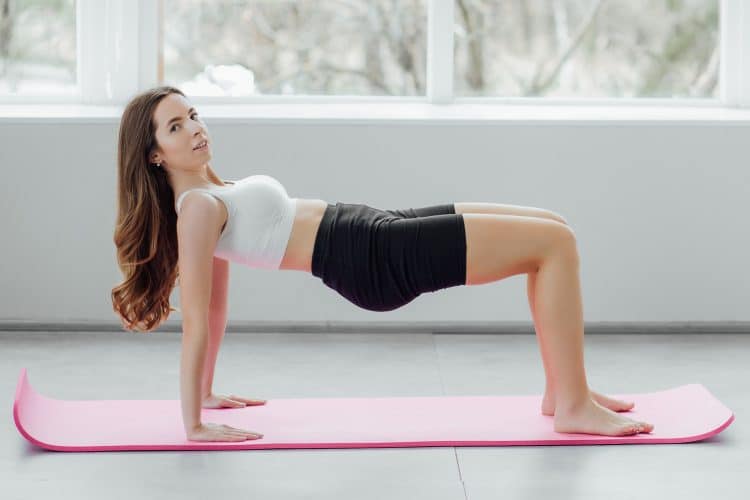
How to do it:
- Sit on the floor with your legs bent to around 90 degrees. Place your hands on the floor just behind your hips, fingers pointing slightly outward or straight ahead as preferred.
- Push your shoulders down and back, drive your palms into the floor, and extend your elbows to lift your butt a few inches off the ground. Look straight ahead.
- Pushing through your heels, push your hips up as high as possible so your torso is parallel with the floor. You should feel a strong contraction in all the muscles on the back of your body.
- Increase the stretch by allowing your hips to drift forward.
- Hold for the desired duration, e.g., 20 seconds, and then relax.
5. Hands behind the back chest stretch
The best way to rapidly improve your chest flexibility is to stretch little and often. 20-30 seconds 5 to 10 times a day will rapidly restore lost flexibility. But, of course, to stretch that often, you need exercises that are convenient and easy to do – like this one! With the hands behind the back chest stretch, you can stretch your pecs almost anywhere and anytime.
How to do it:
- Stand in a comfortable stance, knees slightly bent for balance.
- Put your hands behind your back and interlace your fingers, palms facing inward.
- Push your arms down and back while simultaneously shrugging your shoulders to the rear.
- Hold this position for 30-60 seconds. Go a little deeper as you feel your muscles relax.
6. Prisoner chest stretch
This exercise is so-called because, when you do it, you look a little like you are about to be handcuffed. Don’t let the name put you off; this is a very convenient and effective way to stretch your pecs. It’s also known as the hands on your head chest stretch.
How to do it:
- Seated or standing, raise your hands and place them on the back of your head. Interlace your fingers. Push your head back into your hands to gently extend your neck.
- Next, push your elbows back and open your chest. As well as a stretch in your pecs, you should feel a strong contraction between your shoulder blades.
- Hold this position for 30-60 seconds. Go a little deeper as you feel your muscles relax.
7. Camel pose
This challenging yoga pose will not only open and stretch your chest but also stretches the entire front of your body, from your knees to your shoulders. This is an excellent postural exercise, but for some people, it may be a little too taxing, so ease into it. If you can’t do this exercise, that’s a strong indicator that you need to work on your flexibility.
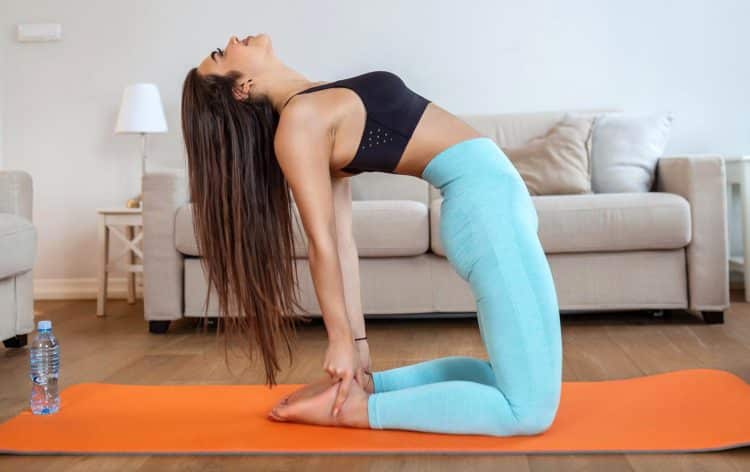
How to do it:
- Kneel down, so your thighs and body are vertical.
- Lean back and place your hands on the backs of your ankles.
- Push your hips forward and lift your chest to stretch all the muscles on the front of your body.
- Hold this position for 30-60 seconds. Go a little deeper as you feel your muscles relax.
8. Standing chest opener
The problem with static or stationary chest stretches is that they usually lead to muscle relaxation. That’s not a problem after a workout, but that’s the last thing you want before hitting the weights or pumping out some push-ups. This dynamic chest stretch won’t put your pecs to sleep but will open and warm up your chest, so it’s ideal for use before training.
How to do it:
- Stand with your feet together, arms by your sides.
- Raise your arms up and out to form a T-shape.
- Extend your arms behind you, lift your chest, and arch your back to get a good stretch in your pecs.
- Smoothly bring your arms forward and repeat.
- Do 6 to 10 slow reps to stretch your pecs and mobilize your shoulders.
9. Stability ball chest stretch
Using a stability ball to stretch your chest may seem like overkill but it means you can subtly move your arm to target any localized muscle tension and stiffness. Also, working one side at a time means you can address any left-to-right flexibility imbalances. It’s not uncommon to find you have one pec tighter than the other.
How to do it:
- Kneel down on all fours and then place one arm on a stability ball. Your elbow and shoulder should be flexed to 90 degrees.
- Rotate your upper body away from the ball to stretch your chest.
- Move your elbow up and down to target different fibers of your pecs.
- Hold for 30-60 seconds, going a little deeper as you feel your muscles relax.
10. Wall angels
This exercise is a part stretching and part strengthening exercise. As you work to increase chest flexibility, your upper back muscles also get a great workout. Wall angels are a very effective exercise for improving your posture.
How to do it:
- Stand with your back against a smooth wall, feet a few inches out in front of you.
- Bend your elbows to 90 degrees and press them against the wall. Your elbows should be roughly level with your shoulders. Press the backs of your hands flat against the wall, too.
- Without moving away from the wall, slide your hands up the wall as far as you can. Keep pressing your arms and shoulders back.
- Return to the starting position and repeat.
- You can also do this exercise lying flat on the floor, which may feel a little easier.
11. Foam roller chest stretch
This gentle stretch is a great way to stretch your chest passively and while relaxing. It’s an excellent stretch before bed or whenever you want to grab a few minutes of peace and quiet. Because it’s such an easy stretch, you can do it for several minutes at a time. Longer stretches are an effective way to rapidly improve flexibility.
How to do it:
- Place your foam roller on the floor and then lie on it, so it runs up the middle of your back. Your legs should be bent and feet flat for balance.
- Make sure the end of the roller is behind your head to support your neck.
- Place your arms out to the sides, with the backs of your hands and forearms resting on the floor.
- Let gravity gently pull your shoulders back to stretch your chest.
- Relax for 2-5 minutes.
More related resources:
- Stiff Hips? Do This One Daily Exercise to Unstick & Strengthen
- I Swapped Cardio for HIIT Workouts for 30 Days: The Results Shocked Me
- Don’t Just Sit There! 8 Useful Things to Do Between Sets in The Gym
- Essential 6-Minute Stretching Sequence for Immediate Muscle Relief
- Partner-Assisted Stretching: Just Lazy or the Key to Optimizing Your Flexibility?
Chest Stretches – Wrapping Up
Everybody LOVES training their pecs. After all, what’s better than a chest pump? But, as well as building and strengthening your chest, you also need to stretch it. Tight pecs can ruin your posture and wreak havoc on your shoulders and posture.
So, get into the habit of stretching your pecs after every workout, and not just on the days you train your chest. Better still, stretch your pecs several times each day to maximize flexibility and eliminate tightness. Set a reminder on your phone and stretch your chest a few times a day.
Hold your chosen stretch for 30-60 seconds and gradually move into a deeper stretch as you feel your muscles relax. However, don’t force the movement or bounce as this can lead to injury. Instead, move into a position of mild tension and hold it there, backing off if you feel any burning or shaking.
A few minutes of stretching each day will have a massive impact on how your muscles feel and function.

